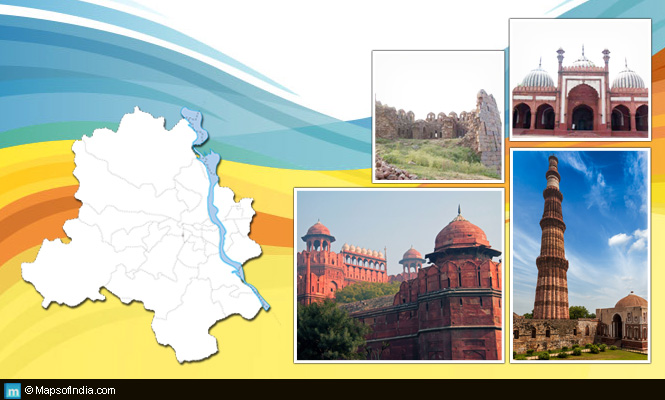 Since time immemorial Delhi has been the Capital of many rulers. There were the Maurya dynasty, the Tomars and Chauhans, Mamluk (Slave), Khilji, Tughlaq, Lodi and Sayyid dynasties and the Mughals. Each dynasty created its own buildings and monuments as per their needs and to promote their art and culture. This gave Delhi an assorted range of historic forts and monuments like Red Fort, Old Fort, Humayun’s tomb, Qutub Minar, Jama Masjid etc that added to the rich heritage of the Capital. These invaluable heritages today present a devastated look due to negligence in handling and preserving them.
Since time immemorial Delhi has been the Capital of many rulers. There were the Maurya dynasty, the Tomars and Chauhans, Mamluk (Slave), Khilji, Tughlaq, Lodi and Sayyid dynasties and the Mughals. Each dynasty created its own buildings and monuments as per their needs and to promote their art and culture. This gave Delhi an assorted range of historic forts and monuments like Red Fort, Old Fort, Humayun’s tomb, Qutub Minar, Jama Masjid etc that added to the rich heritage of the Capital. These invaluable heritages today present a devastated look due to negligence in handling and preserving them.
Delhi boasts of about 1,300 such structures but only 174 of them have received national importance and are protected by the Archaeological Survey of India. The ASI is planning to undertake conservation of a few more monuments coming under its purview and has outsourced the task to private companies. The authorities find it difficult to protect all the heritage buildings for various reasons. But it is extremely important to preserve them because of their historical and cultural values and also because of their economic value as they bring revenue to the exchequer by way of providing meaningful openings for the tourism industry.
Monuments in India are conserved at the Central and State levels. All the monuments that hold national importance are looked after by the Central Government whereas ‘other monuments’ are looked after by the respective State Government. Monument conservation is not compulsory at city level so many a time these historic buildings are altogether neglected.
Conservation of monuments in Delhi – A brief overview
Conserving old monuments and buildings is not new to Delhi.
- In the 3rd century BC Emperor Asoka ordered to conserve wildlife.
- Firuz Shah Tughlaq ordered to save ancient buildings in the 14th century AD.
- The “Bengal Regulation (XIX)” passed in 1810 and the “Madras Regulation (VII)” passed in 1817 under the British Rule were meant to preserve heritage buildings. These gave powers to the Government to step in, in case of threat to any public building.
- To protect historical buildings all over India, the Archaeological Survey, the forerunner of ASI, was established in 1861.
- In 1905, 20 historic buildings in Delhi were listed for protection. At the time of independence ASI protected 151 buildings and complexes in Delhi.
- Delhi had its the State Department of Archaeological Survey in 1978 to take care of those monuments which were de-notified by the ASI.
The ASI still uses the list of 1317 monuments prepared by Maulvi Zafar Hasan. He prepared the list in four volumes as “Hindu and Mohammaden buildings in Delhi” between 1916 and 1922. Conditions of many structures in Delhi is very bad, most of these have collapsed, some have been demolished and others have been illegally occupied or encroached.
The ASI is taking care of the Centrally protected monuments and even sharing the work with private sector. Despite all such efforts Delhi still has more than 1,000 unprotected monuments such as Tomb of Razia Sultan, Mirza Ghalib’s House, Sher Mandal, Namak Haram ki Haveli etc. According to the National Mission on Monuments and Antiquities, the Capital has 1,180 unprotected monuments. The conservation NGO, Indian National Trust for Arts and Cultural Heritage, had earlier come up with a list containing 1,200-odd heritage buildings. There is no policy to protect the unprotected monuments.
As per the ASI, lack of “skilled manpower” with hands-on experience is the reason for the poor condition of historical monuments in Delhi. Also the Government policies do not allow the expansion of the ASI.
Shoddy work being done
Even if some of the monuments are well-preserved then also their condition is not that good. Tourists and visitors are often seen complaining about the bad shape of the building. The task of preserving Humayun’s tomb was outsourced in 2003. Though the monument has seen an increase in the number of visitors but still they complain about the condition of the monument and its surrounding area.
Lack of funds is another hurdle in preserving these important historical monuments in Delhi.
It is not only the Government that is at fault but the people visiting these monuments are equally blamed. People litter a lot and even deface these monuments. Delhi must be proud of these historical monuments but they use these to show their grafitti talent.
The Government must promote the monuments having historical significance to create awareness about the importance of the buildings.
The Government must acquire skilled manpower and the ASI must supervise the conservation programme. We must understand that both protected as well as unprotected monuments have enormous potential in terms of revenue and tourism. Above that, protecting these is important because these old-age monuments are an integral part of Delhi.





